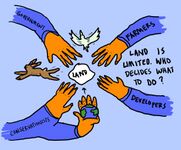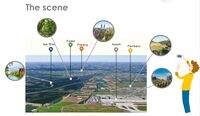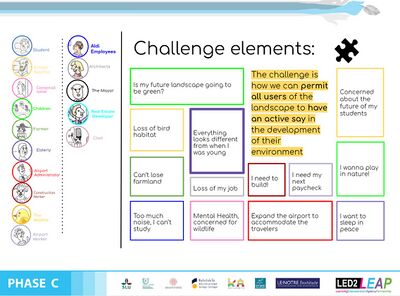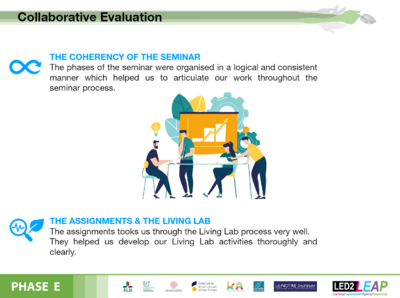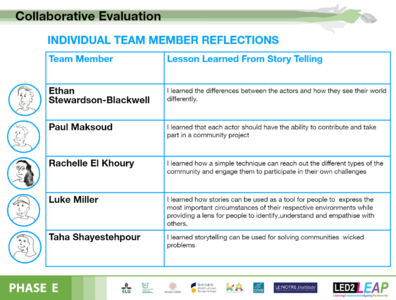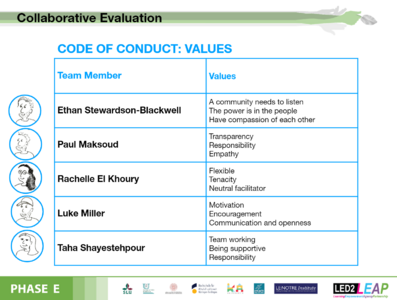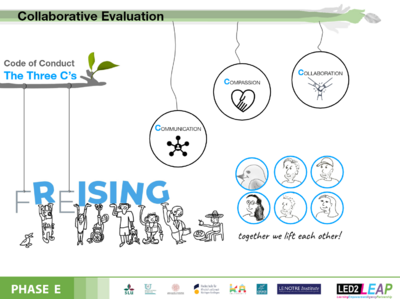LED2LEAP 2020 - Freising Team 1
>>>back to working groups overview
Landscape Democracy Rationale
- The community context is relevant because the landscape is function of how the community sees the landscape. As we understand how the community interprets the landscape we can build a better landscape that works for them. As our community grows we want to ensure the health and wellness of both the humans and the natural landscape.
- How does the landscape work for the benefit of human health and wellness? How can we bring community together to provide a healthy and happy life? That is the hypothesis considering the landscape democracy challenges.
Location and scope
- The overall location is the space between the two points, the Munich Airport and Dachau.
- Our main focus area is the Airport region south of Freising. Notice the large yellow areas around the airport, that is farmland and pasture. Also notice the water bodies surrounding the airport, they play an important part to the health of the area.
Phase A: Mapping your Community
Welcome to your community and its landscape
- The west side of the Munich Airport.
- Industural, agricultural, and nature land types.
- Freising is a young comunity.
- Issues with urban spraul, and maintaining a productive agricultural economy while allowing a positive life for humans and nature.
Groups of actors and stakeholders in your community
- Key Actors (Local Residents, Municipalities, Government, Landowners)
- Primary Actors (University, Schools, Students, Elderly, Families, Farmers, Airport Administration, Airport Employees, Unions, Munich commuters) These actors are concerned with their own health and those around them
- Secondary Actors (Small businesses, Tourists, Community Centers, Beer production, Religious Centers)
- The most visible actors are the landowners, the University and the Airport. All others are less visible.
- What we don't know is the direct thoughts of the citizens, we are working off assumptions based on reading and research.
Relationships between your actors and groups
- The power relationship is complicated but overall the large groups have more power than the smaller actors.
- Food production brings together the landowners, farmers, business owners and government regulators.
- Many groups have a shared interest in the Airport and its functions. The workers, administrators, tourists, and people in the transportation sector have a lot of stake in the airport.
Summary of your learnings from the transnational discussion panel on April 22
- From the meeting on April 22, we learned about different ways to view the landscape. From on of the talks we leaned more about the power structures and socioeconomic differences that lead to the benefit of one group but not of the other. We learned of a better way to present information and how to show what we did and not to tell what we did.
Theory reflection
- From the article The Just City Essays - 26 Visions for Urban Equity, Inclusion and Opportunity I got a better perspective on what is important for community inclusion. Being a good member of a community means having the goal of justice at the forefront of design. I want to think about how the design will positively or negatively influence the different members of the community and make changes from that.
- The article Pledge for a Transformative Science - A conceptual framework showed me the future thought process in how we use the scientific method. It reminded me a lot of the iterative process of having a problem, working to find a solution and then building off what you learned to continuously improve that was talked about in the lecture. I also like the holistic approach the article took about science.
- In The Right to Landscape: An Introduction, in: The Right to Landscape: Contesting Landscape and Human Rights, we learned how the right to landscape is a human rights issue. Landscape can provide many things, health and physical well being, mental well being, and economic well being. We need to focus on how we can up lift communities without landscape and create an environment that everyone can thrive in.
References
- The Just City Essays - 26 Visions for Urban Equity, Inclusion and Opportunity [1]
- Alejandro Aravena: My architectural philosophy? Bring the community into the process [2]
- Higher Education System in Germany [3]
- EVG [4]
- GEW [5]
- IGBAU [6]
- Pledge for a Transformative Science - A conceptual framework [7]
Phase B: Democratic Landscape Analysis and Assessment
The Scene in your Story of Analysis
- The landscape democracy challenge we face in our area is the expansion of the Airport to build a third runway. The expansion will harm the protected bird areas and reduce farm land, however, the expansion will also provide jobs for people and be a benefit for the economy. The scene we tell our story in is around the Airport area, incorporating the Isar River, the farmland and the city. The area has a low unemployment rate and has many young families and airport workers. Politics are based around the Airport Administration and local government.
The Actors in your Story of Analysis
- The characters in the story are the farmers, airport workers, airport administrators, construction workers, families, teachers and students. The main character is a student that is motivated by minor characters (farmers, families and teachers) to organize a protest against the expansion of the airport. This protest is countered by other minor characters (airport workers, construction workers and airport administrators). The relationship between the construction workers and the airport is very strong. If the construction takes place the workers are needed. The farmers need their land and will be greatly affected by the expansion.
The Story of Analysis
- The story begins with a student on a plane arriving to Freising without a place to stay. On the plane they meet a nice elementary school teacher who offers a bed for the night. The student learns from a farmer and the family the issues with the expansion of the airport. Sitting by the Isar river the student is motivated to organize a protest about the expansion of the airport. During the protest a counter protest starts from the construction workers and airport workers. This opens up the students mind and creates a wicked problem in their mind. The student sees a need for community engagement and works with the Environmental Autobiography Adaptation method and the community members. Through this method the all community members learn about the other.
Reflect on your Story of Analysis
- The tool we chose to utilize in the community fit our community best because it allowed the members to be active and engaged while allowing for the other members to get a valuable and intimate look into their lives. What we carried was different points of view, community relations and the relationship between different histories. Why did we carry? We carried because we needed to understand the community better and have the community understand itself better. How did we carry? We carried using empathy, flexibility and humility for our fellow community members. What we want to leave behind is a better understanding of the community and the connections they all share. Overall, the actors we gathered, are from different parts of society, and each lead very different lives. Therefore, the sketches that they will produce will most certainly view the issue from different vantage points. This is essential to understand the community, and this method provides this flexibility in a very calming setting. It is also a good exercise to self reflect on one's own values and expectations from this community.
Phase C: Collaborative Visioning and Goal Setting
The Scene in your Story of Visioning
- The challenge is how we can permit all users of the landscape to have an active say in the development of their environment
- add the corresponding visual from your presentation to the image gallery below
The Actors in your Story of Visioning
- All the characters from the image below have a part in the visioning phase. They were chosen because of their unique part in the community. The visioning phase will take place in a public space that is accessible for all members.
The Story of Visioning
- The crux of the story is how the different actors can all feel like they have a place in the community. To prioritize the goals after the development phase the community looked at what were the most inclusive goals.
- The vision our community came up with was "Freising is Rising, together we lift each other up".
- Year 1: Research different actor groups and see where they use community space.
Analyze data and see what a suitable area would be. After that begin to research techniques and interventions that could bring in different actor groups, through community and municipality engagement. Near the end of the year present the result to the community for feedback. Year 2: Review the success of previous techniques and interventions. Assess what worked and what didn’t work. Start a marketing campaign to tell the rest of the community about the project to entice them to join. Get permits and regulations approved in order to create the space. Raise the funds required to build the project. Mobilize the community to prepare them for implementing the new garden design in the chosen site. Year 3: Get the required material to start building. Get in contact with construction workers to prepare the plot. Mobilize the diverse community to start implementing the design. Get help from the farmers to plant the garden, and teach the children about gardening. Allow the students to document the community engagement. Have a celebration for the opening. Keep on monitoring the community engagement in maintenance. Have a community PARTY!
Reflect on your Story of Visioning
- The most important points were balance and communication. The others listed below were also important. The common characteristics of a good vision were to have collaboration and understanding.
Phase D: Collaborative Design, Transformation and Planning
Your Prototyping Action
- The prototyping action we tried to achieve in Phase D was to bring the community together and have them "build" a garden together. We want to create an inclusive and connected community and the prototype will bring the community together. Phase C showed us the importance of bringing communities together.
The Evolution of Your Prototyping Action
- The actors in the community that worked on this prototype were various community members from different parts of Freising. They all came together in an active collaborative design process to shape a new garden landscape. The tools we used were cardboard landscape pieces and larger cardboard landscape elements. We also had tools for documentation.
The Plan Behind Your Prototyping Action
- The resources we needed for the prototype were large map puzzle, pathways, cardboard landscape pieces, colored stickers, pens, community members and snacks. The resources we needed for the documentation were consent forms, note sheets and people to document. The puzzle pieces, pathways and landscape pieces were placed around the space to simulate the landscape. The stickers were used to show likes or dislikes about the design. The roles created were one person to lead the exercise, one person to explain more about the process and one person to document the process. The timeline was to have 20 minutes to set up the puzzle, 30 minutes to move pieces around, 30 minutes to reflect, 30 minutes to move around again and 10 minutes to discuss.
The Realization of Your Prototyping Action
- When the participants arrived they had time to introduce themselves and start to build the puzzle with numbers and corresponding pieces. It was a fun and joyful atmosphere. There was some conflict with the participants but it went well. The participants wrote down their responses to the process and how they felt about different aspects of the prototype.
Reflect on Your Prototyping Action
- Our intervention gave the community a space to get a better understanding for each other. It also allowed the community to get a better understanding about what they want in the community spaces. For future prototypes have a higher fidelity prototype for the community to interact with could help with a better understanding of the community space. The amount of community input from the feedback sticker is a good indicator about how successful the process was. If the community was involved with each other and interaction this could also be a success factor. This intervention reflected on the lectures and case studies presented, especially the Budafok Downtown case study where the community worked together to envision a future space.
Phase E: Collaborative Evaluation and Future Agendas
Collaborative Evaluation and Landscape Democracy Reflection
- Our landscape democracy challenge changed over the course of this class. We started focusing on the expansion of the Munich Airport but moved to something more general. We choose to look at the challenge of creating an inclusive community in Freising. Both of these challenges dealt with the UN Sustainable Development Goals of Good Health and Wellbeing (3), Sustainable Cities and Communities (11), Life on Land (15) and Partnerships for the Goals (17). Our work with the community showed us how the community felt about their community. We modified our goals to create a more general framework for solving the communities issues. ’'
The Actors in your Collaborative Evaluation
- ’'The stakeholders in our community are a wide range of people from the mayor to the grocery store worker. There is a power structure with the people who have and the people who have not. The people in positions of power have the ability to create and enact change. We found that the when the people work together real change will occur. As for our role we can be facilitators of this change and help bring the community together. Our role has changed to be a person that can be there to help and listen and learn.
Reflection of the Online Seminar
- ’'The pandemic kept us from a large amount of in person communication with community members. We did preform surveys to learn about the community but were limited on the amount of information we could receive. The theoretical material was very helpful to understand the basis for all the actions we could preform. The assignments took us through the process of community engagement and were helpful for our understanding.’'
Reflection of the Living Lab Process
- ’'Because of COVID-19 we were only able to create a theoretical model of our community based on our survey results and limited communication with the community. However we made a good run at it and I feel like we got a good understanding of the community and the living lab activities were a good exercise. The outputs were what designs and prototypes we created through the living lab process. The impacts were limited to feedback from some community members describing our process. The indicators we used were the reaction (positive or negative) of the community when we described the process to create a more inclusive Freising. ’'
Your Living Lab Code of Conduct
- ’’ The main values our group held were the three C's Communication, Compassion and Collaboration. Keeping these three values in mind we found that the result of our design or prototype or activity will be enhanced and create better outputs. ’’
Process Reflection
- The group that we have worked very well together. The differences we have were explored and highlighted and it was an enjoyable experience. It was also enjoyable to see different groups from different countries and understand their values in a landscape democracy context. The limitations were not so great that we couldn't get work done. Distance learning and not being able to work face to face was hard but doable. We learned a lot about each others values and cultures that helped us bond and grow together. We learned about different working styles and how we can work together the best. We learned what different values we all hold and how we bring that into the collaboration process. Next time I think we would work together more to get an even better understanding of each other but other than that it went very well and we were all satisfied with how we worked together and the outcomes we produced.







